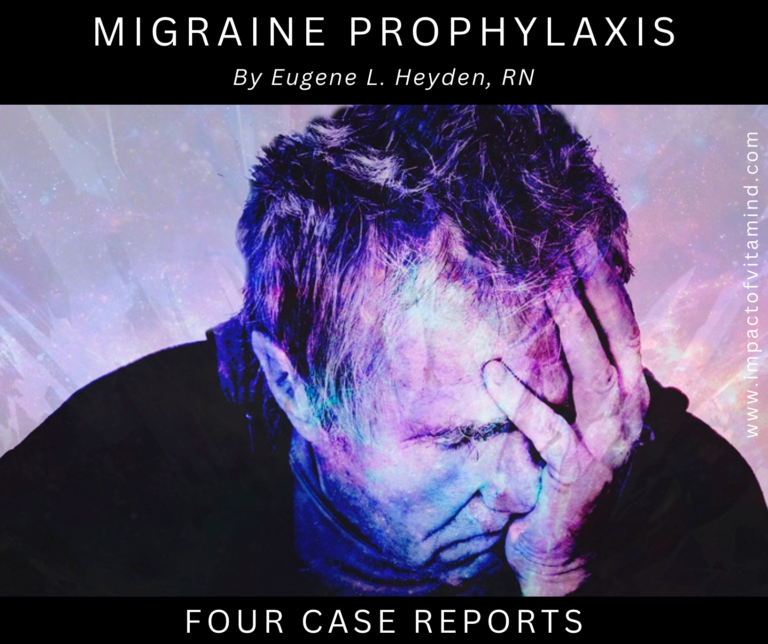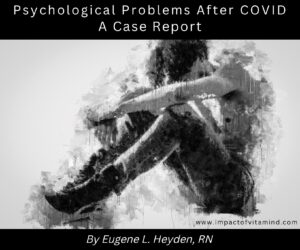Migraine Prophylaxis

By Eugene L., Heyden, RN
“Migraine is a condition that significantly impairs patients’ quality of daily life. The Global Burden of Disease Study ranked migraine as the seventh most common disabling pathology among 289 diseases, referred to as the 7th disabler.” ~Koyuncu Irmak et al., 2019
“Verapamil has been used quite successfully in a subset of patients for migraine prophylaxis since the 1980s. In our practice, verapamil is frequently offered to patients who have not responded to or been intolerant to several of the treatments recommended by the guidelines.” ~Cutrer er al., 2021
The use of a medication for a purpose other than intended is called off-label use. Doctors can do this because they are trained to look for opportunities . . . and programmed to act. And if done wisely and with care, a physician (and patient) may achieve success with the use of an off-label drug and do so with less risk than would occur using a conventional drug. And when it comes to migraine prophylaxis, I’ve seen it action. In this post, I will share the stories of 4 migraine patients who received relief from their migraines by the off-label use of a calcium channel blocker.
Patient 1
My dear mother was plagued by severe migraine headaches, daily and for years, until they vanished overnight. They vanished because someone saw an opportunity and used an off-label approach to address the problem.
About 4 decades ago, a new cardiac drug hit the market that could safely reduce the heart rate of individuals with fast heart rhythms. The drug is called verapamil (Calan). Unexpectedly, many cardiac patients who were placed on the drug, and who also suffered from migraine headaches, began reporting prompt relief. Someone took notice and began prescribing verapamil specifically to treat migraine headaches. Other physicians caught on and began doing the same. And just like that, an off-label treatment for the migraine headache was born. I learned of this way back when, shared this information with my mother, who subsequently obtained a prescription for verapamil. And if my memory serves me correctly, after the very first dose, she had her first headache-free day in years. She continued taking the drug for forty-plus years with consistent results. Unfortunately, during the last few years of her life, her blood pressure was too low to safely take verapamil. The drug was appropriately discontinued, and as if on cue, her migraine headaches returned. But migraine prophylaxis was once again achieved by the use of a medication know as valproic acid (Depakote).
Patient 2
Verapamil is not the only calcium channel blocker that has been successfully used, off-label, for the prevention of the migraine headache. We can ask the doctor about this.
Patient 2 is a 35-year-old physician who had had enough of her migraine headaches. It all started when she was a teenager. At the time, the migraines were treated somewhat successfully with NSAIDs and ergotamines (e.g., Cafergot), and then her migraine headaches became a thing of the past. But in her 20’s they reappeared but occurred only once or twice a year. Unfortunately, this would all change.
“. . . after the birth of her first child, she developed increasingly frequent migraine. Most were unilateral, either left or right, and associated with nausea, vomiting, photophobia, phonophobia, and occasional upper extremity tingling. All of her headaches were around menstrual periods and lasted 9 to 12 hours. She had one or two severe headaches a month. She sometimes also suffered from basilar migraine.” (Dandapani and Hanson, 1998)
Several medications (the usual), and including verapamil, were tried but did not provide relief. And due to her asthma, she was unable to take a beta-blocker, a drug class that is also used to treat migraines. And then quite by accident, relief was on the way.
“She was started on amlodipine [Norvasc] 5 mg by her internist for transient essential hypertension. Surprisingly, there was complete resolution of the headaches. She has not required any prophylactic medications or abortive medications for 1 year in follow-up. Her menstrual periods have not changed, but she is free of headaches. There have been no side effects of amlodipine except mild pedal edema. Her blood pressure is normal, but she refuses to discontinue the medication for fear of headache recurrence.” (Dandapani and Hanson, 1998)
Patient 3
Patient 3 is a 27-year-old male, serving in the military at the time his migraines were successfully treated. He was formally diagnosed as having migraine headaches approximately 11 years prior. At presentation, his medical chart included a neurological work-up and the report of normal CT scan. I suppose war is not an ideal setting for an individual who suffers from migraine headaches. Just saying!
“He described a right-sided frontal pounding headache with associated phonophobia and photophobia, but no aura. There were no signs or symptoms to suggest cluster headache or paroxysmal hemicrania. Headache frequency had increased dramatically during his military deployment to a level of 4–5 episodes per week, with a background chronic bifrontal headache that rarely resolved.” (Leonard and Phillips, 2007)
This degree of suffering is, of course, unacceptable. Initially, treatment included an increase if the drug the patient was already taking, that being topiramate. Unfortunately, this did not help, and neither did Migratine plus ibuprofen. And on three separate occasions, over a period of three weeks, he required I.V. medication (ketorolac and prochlorperazine) to gain control of the situation. Things were that bad. Well, this can’t continue! And it didn’t.
The patient, who incidentally was a medic in an active war zone, was given a new life. “He was placed on amlodipine 10 mg per day and other meds were slowly weaned off. And the result? His headaches remained quiescent despite his continued participation in daily missions. He required no further visits to the aid station for refractory headaches over the ensuing 30-day period.” (Leonard and Phillips, 2007)
Patient 4
This is the last patient in the series.
Thirty years of suffering from migraines is long enough. Let’s hope someone will give our 63-year-old patient a therapeutic trial of amlodipine. Oh! Someone already did . . . and it worked!
In addition to having a phobic disorder, treated by desipramin, Patient 4 had the classic migraine attacks—“associated with visual aura, mostly unilateral, and lasted for 1 to 2 days. The headaches persisted even after menopause.” (Dandapani and Hanson, 1998) Her migraines occurred five or six times a month and was resistant to standard medical treatment, unpredictable, and at times most severe. She can’t even begin to count all the doctors she had seen over the years in search of relief. (I made that up but am probably right.) And although delayed, help was on the way.
“Based on the experience with the previous patient [Patient 2] we started her on amlodipine 5 mg even though she had no history of hypertension. She continued her care with the psychiatrist and continued on desipramine. After 6 weeks, there was dramatic decrease in the headache frequency to 1 to 2 a month. She was maintained at the same dose with no adverse side effects except pedal edema. She has been headache-free for 8 months. Her blood pressure continues to be in the normal range. She has not required any analgesics. Her quality of life has improved remarkably and she is able to travel freely without fear of having a migraine.” (Dandapani and Hanson, 1998)
Conclusion
From the above case reports, one can easily see that there is hope for the migraine patient apart from standard medical therapy, by the off-label use of verapamil or amlodipine. There are no guarantees in life, but I like what I’m hearing. And I’ll never forget the difference verapamil made in the life of my dear mother.
Recommended post (Click image to open)
References
Cutrer FM, Moyer AM, Atkinson EJ, Wang L, Tian S, Wu Y, Garza I, Robertson CE, Huebert CA, Moore BE, Klein CJ. Genetic variants related to successful migraine prophylaxis with verapamil. Molecular Genetics & Genomic Medicine. 2021 Jun;9(6):e1680. https://onlinelibrary.wiley.com/doi/abs/10.1002/mgg3.1680
Dandapani BK, Hanson MR. Amlodipine for migraine prophylaxis. Headache: The Journal of Head and Face Pain. 1998 Sep;38(8):624-6. https://headachejournal.onlinelibrary.wiley.com/doi/abs/10.1046/j.1526-4610.1998.3808624.x
Koyuncu Irmak D, Kilinc E, Tore F. Shared fate of meningeal mast cells and sensory neurons in migraine. Frontiers in cellular neuroscience. 2019:136. https://www.frontiersin.org/articles/10.3389/fncel.2019.00136/full?fbclid=IwAR35NWfWT3wIItN8-q5R6v70pqa8q7WGN19JtAEXrL1eyj2qiDR2dJCokqc
Leonard L, Phillips WJ. Near-complete migraine prophylaxis with amlodipine: a case report. Journal of pain and symptom management. 2007 Dec 1;34(6):571-3. https://www.jpsmjournal.com/article/S0885-3924(07)00593-3/abstract
DISCLAIMER: This article is offered solely for informational purposes. The information contained therein and opinions expressed should be evaluated for accuracy and validity in the context of opposing data, new information, and the views and recommendations of a qualified health care professional, and not to be substituted for professional judgment and guidance or to provide a reason to neglect or delay appropriate medical care for self or for others. It is the reader and reader only who bears the responsibility for any actions that could be construed as being a response to the information presented. The statements and opinions expressed by the author have not been reviewed or approved by the FDA or by any other authoritative body, nor is the author endorsing any product or specific therapy mentioned. This article and the opinions contained therein are offered to the reader to broaden his or her understanding of the issues discussed and to help identify options that may be suitable for the individual to pursue, on behalf of self or others, under approval and direction of a qualified physician or medical team member. All questions of a medical nature which arise from reading this article should be directed at qualified health care professional. There are no guarantees that a suggested website and internal links are safe to visit or open or are currently available.
Copyright © 2022 Eugene L. Heyden, RN
All Rights Reserved

